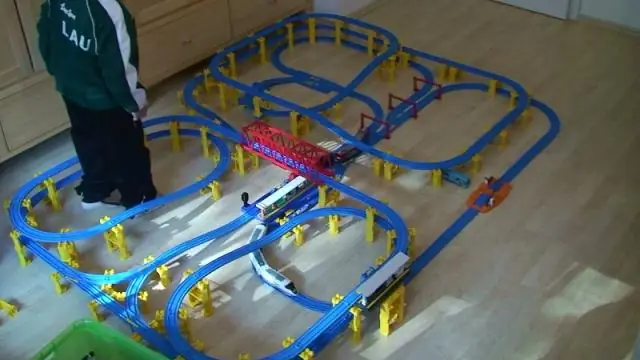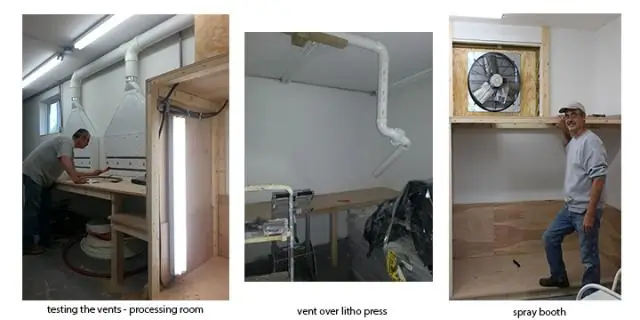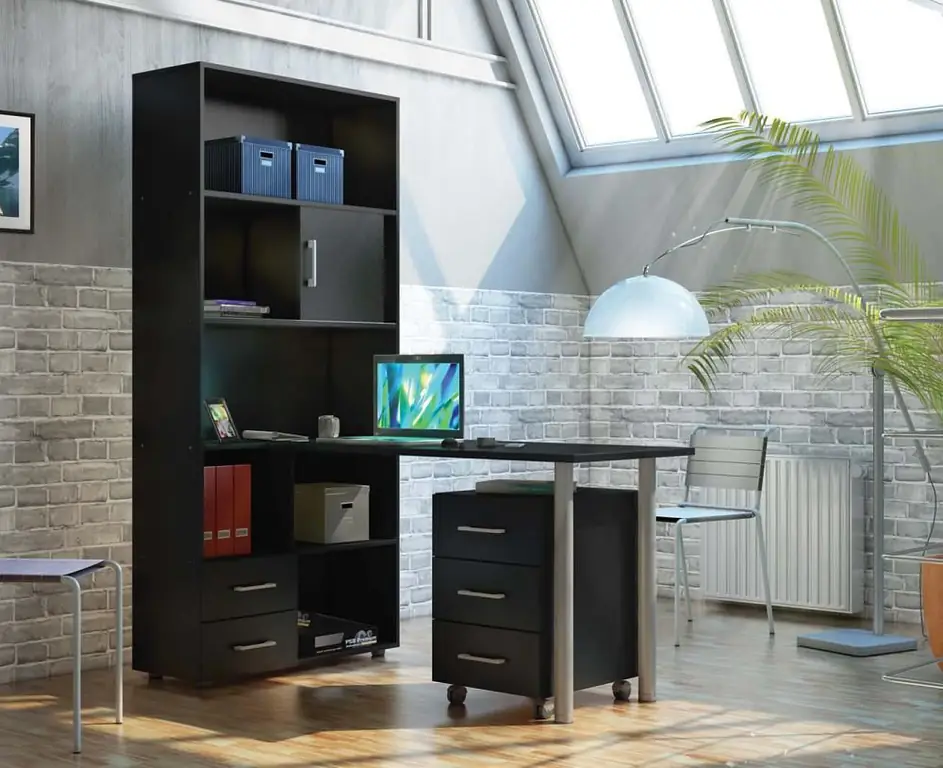
Table of contents:
- DIY bunk bed, or whistle everyone upstairs
- Pros and cons of bunk beds
- What materials will be needed for work
- Bed ladder designs suitable for different ages
- The first step is to create a drawing
- Making a bed from wood: step by step instructions
- We make two tiers from one
- How to assemble a pull-out model
- The most durable option is a metal pipe bed
- Plywood frame folding structure
- Author Bailey Albertson [email protected].
- Public 2024-01-17 22:26.
- Last modified 2025-01-23 12:41.
DIY bunk bed, or whistle everyone upstairs

The dimensions of the apartment do not always allow placing sleeping places so that there is free space. Cluttering a room with folding beds is not the best solution. A hand-made bunk bed will help to cope with the problem and save space.
Content
-
1 Pros and cons of bunk beds
-
1.1 Children's bunk beds
1.1.1 Unusual options for two-tier structures for the child in the photo
-
1.2 Two-tier constructions for adults
- 1.2.1 Do-it-yourself bunk bed - video
- 1.2.2 Options for double beds for adults and combination models - gallery
-
-
2 What materials will be needed for work
2.1 Bunk beds made of different materials - gallery
- 3 Bed ladder designs suitable for different ages
-
4 The first step is to create a drawing
- 4.1 How to create a bed scheme on a computer - video
- 4.2 Drawings of different models of bunk beds - gallery
-
5 Making a bed out of wood: step by step instructions
5.1 How to make a bunk bed from solid wood - video
- 6 We make two tiers from one
- 7 How to assemble the pull-out model
- 8 The most durable option is a metal bed made of pipes
-
9 Tiltable plywood frame construction
9.1 Do-it-yourself folding bunk bed - video
Pros and cons of bunk beds
Purchased products are expensive, moreover, they do not take into account the peculiarities of the premises where they will be installed. Therefore, it makes sense to make a two-tier structure on your own, combine it with a study table or storage cabinet, provide drawers under the lower tier.

The main plus of bunk beds is a significant saving of space in the apartment.
The simplest summer cottage option can be made by any home craftsman who owns a tool in the slightest degree and has the skills to work with wood. In a city apartment, such beds are most often installed in a nursery. This allows you to free up space for games and activities.
The minus of the design is the increased risk of injury. If you decide to install such a structure in the nursery, take care of a reliable side on the second tier of the bed so that the child is safe. In any case, you cannot put a baby under three years old to sleep on the second tier.
Children's bunk beds
The size of the bed for a baby bed is determined by the standard dimensions of the mattresses. As a rule, it is 160x70 cm. There are transforming beds that provide for lengthening the berth as the child grows.
You can make various options for a baby bed yourself:
- classic, for two children;
- a variety of the first option - for three or four children;
- a loft bed for one child, where the sleeping place is located at the top, and there is a place for classes at the bottom;
- angular, when the upper and lower berths are located at an angle of 90 degrees to each other;
- with a retractable bottom tier;
- folding.
Unusual options for two-tier structures for a child in the photo
-

Classic bunk bed - Classic bunk bed suitable for two children
-

Corner bunk bed -
Corner bunk bed with study space saves space in the nursery
-

Convertible bed with pull-out berth - A transforming bed with a pull-out lower berth is an excellent solution for a small apartment
-

Bunk bed with slide - A bunk bed with a slide and a whole range of equipment will appeal to little athletes
-

Bunk bed-transformer with a table - A convertible bunk bed with a pull-out berth and a table provides the child with a full-fledged place to sleep and study
-

Loft bed - Loft bed suitable for one child
-

House-shaped bunk bed -
A house-shaped bunk bed is a great place to sleep and play
-

Combined bunk bed - Combined bunk bed, decorated in a nautical style, will appeal to a young dreamer
-

Loft bed with sofa on the lower tier - A loft bed with a sofa on the lower tier provides a place to sleep for mom and baby
-

Bunk bed with bent legs - The original bunk bed with bent legs and a wide lower berth will fit into any interior
-

Bunk bed, designed in the form of cars - Bunk bed designed in the form of cars will appeal to boys
-

Folding bunk bed - A folding bunk bed is a great way to save space for games and activities
-

Bunk bed with drawers - A bunk bed with drawers, cupboards and shelves allows you to place a lot of necessary children's things
-

Wooden bed with different bed widths - Wooden bed with different widths of sleeping places is designed for sleeping children of different ages
Two-tier designs for adults
Bunk beds for adults are most often installed in barracks, camp sites and other places where it is necessary to accommodate a large number of people in a small area. Homemade design is a convenient option for giving.
Do-it-yourself bunk bed for a summer residence - video
In a one-room apartment, a combined model is useful: the upper seat is for a child, the lower one is for an adult. But there are many options for loft beds, they are suitable for adults and children. If necessary, you can even install a bunk structure with two double beds. It will come in handy when placing guests.
Double bed options for adults and combination models - gallery
-

Adult bunk bed - If the height of the ceilings allows, the bed can be made three-tier
-

Combined version of a bunk bed - Combined version of the bunk bed with a narrower upper seat allows you to accommodate an adult and a child
-

Bunk bed with two double beds - A bunk bed with two double beds is a great option for a large family
-

Metal double bed for adults - The metal double bed has increased durability
-

Folding loft bed - Folding loft bed saves space and does not interfere during the day
-

Loft bed with sofa - The loft bed can be fitted with a sofa for more convenience
-

Built-in loft bed - The built-in loft bed is completely invisible and very cozy
-

Metal folding bunk bed - Metal folding bunk bed - stylish and comfortable interior detail
-

A variant of the combined bed in the form of a tree house - The original version of the combined bed for adults and two children with the style of a tree house will appeal to the whole family
-

Classic combination bunk bed - The classic wooden bunk bed for adults and children will appeal to all the inhabitants of the house
-

Corner loft bed with sofa - Corner loft bed with sofa helps accommodate many guests
What materials will be needed for work
The most popular material for making these beds is wood. But other options are also possible:
- plywood;
- chipboard;
- metal;
- polypropylene pipes.
For inexperienced craftsmen, the simplest material is chipboard or plywood. They are easily sawn with a jigsaw and do not require special processing equipment. The relative cheapness of the material also plays an important role.
Making beds from different materials has its own characteristics.
- Experience is required to work with wood. But the product turns out to be durable and environmentally friendly, which is important when making furniture for children. In addition, wood is much lighter than chipboard.
- Metal will require equipment for welding, cutting and working skills. The beds made from it are the most durable, withstand the maximum load.
- Craftsmen make furniture even from polypropylene pipes. Perhaps such products are not particularly beautiful and sophisticated, but they are very simple to manufacture. All you need is the pipes themselves, a set of fittings, a hacksaw and a drawing.
Bunk beds made of different materials - gallery
-

Wooden bunk bed - Wooden beds are the most environmentally friendly
-

Plywood bed - Plywood decor is suitable for decorating a baby bed
-

Plywood bunk folding bed - For the manufacture of a folding bed, plywood is the best option
-

Chipboard bed - Particleboard is most often used for the production of bunk beds
-

Metal bunk bed - A bunk bed of an original design can be made from metal profile pipes.
Bed ladder designs suitable for different ages
How convenient and safe it will be to climb to the second floor of the bed depends on the stairs. She may be:
- vertical - two planks or bars connected by crossbars made of wood or pipes. Sometimes attached, but most often built-in;
- marching. This is an ordinary staircase with steps. It is made of a board with a section of 30x80 mm, takes up more space than a vertical one, but is much more convenient. The width of the steps should be at least 350 mm, the distance between the rungs should be 200-300 mm. The tilt angle is about 70 degrees;
- with built-in drawers or wardrobes. Since the space under the stairs remains free, it is used as a storage for things, embedding drawers on the side or in the steps, or equipping a wardrobe.
Which ladder to choose? It all depends on who will use it. For adults and adolescents, both first options are suitable, for young children it is more convenient to march, from it there is less chance of falling.
The first step is to create a drawing
Before you start making the bed, you need to make a drawing. With it, you will calculate how much material and fasteners you need. Special design knowledge is not required for this, but some points must be taken into account.
- Leave the distance between the upper and lower tier so that an adult can sit on the lower bed without risking hitting his head on the upper one.
- Leave enough space between the top tier and the ceiling for the child to feel good while sleeping. Warm air rises. If there is not enough space, it will be difficult for the child to breathe.
- When designing a bed, consider the standard sizes of mattresses.
How to create a bed diagram on a computer - video
If self-creation of a drawing is too difficult for you, use ready-made diagrams.
Drawings of different models of bunk beds - gallery
-

Classic bunk bed with integrated ladder - You can make a classic bunk bed with a built-in ladder yourself, using the drawing
-

Chipboard children's bed - A bunk bed made of chipboard with a wardrobe and drawers, made according to the scheme, will appeal to young children
-

Children's bed made of chipboard with a marching ladder - According to the drawing, drawers can be built into the ladder of the baby bed
-

Loft bunk bed drawing - Conveniently integrates a study table into the loft bed
Making a bed from wood: step by step instructions
To make a corner bunk bed, you will need:
- 4 things. wooden beams 50x100x3000 mm;
- 4 things. wooden beams 50x100x2400 mm;
- 2 pcs. boards 20x100x3000 mm;
- 1 PC. - 20x150x3000 mm;
- 1 PC. - 20x200x3000 mm;
- 2 sheets of plywood 12х1200х2400 mm;
- screws 75 mm long;
- self-tapping screws for drywall 40 mm long;
- 8 pcs. screws in a hexagonal head 6x150 mm with washers;
- 10 pieces. bolts 6x75 mm with nuts and washers;
- 2 pcs. bolt 6x150 mm with nuts and washers;
- wood putty;
- sandpaper;
- screwdriver;
- circular saw or hacksaw;
- jigsaw;
- milling cutter;
- drill;
- roulette;
- level.
When all the materials and tools are collected, get to work.
-
Cut the material according to the drawing.

Corner bunk bed Cut the tree according to the bed pattern
- Please note that the size of the frame for the berth must exceed the dimensions of the mattress by 80 mm in length and 100 mm in width. On the side where the ladder will be attached, add another 45 mm.
- At all outer edges, cut a chamfer, you can use a hand plow. Sand and grind the details.
- Make markings for fasteners on all parts.
- Assemble the upper and lower frames from the cut beams, fasten with screws. Make at least one partition to reinforce the structure.
-
Using self-tapping screws, screw the board 20x150 to the two adjacent sides of the frame, and to the other 20x200. They will serve as bumpers.

Manufacturing of sides Screw the sides to the finished frames
- For the corner support legs, connect the 50x100 bars along the length at an angle of 90 degrees so that the end is L-shaped.
- Drill a hole in the support at the place where the upper tier is attached. Do the same in a frame with a 200 mm rim. Drill them out wider so that you can hide the screw head and nut and washer.
- Screw the frame to the rack with screws.
- Now attach the structure to the walls. If the wall is plasterboard, the fasteners must pass through the rack profiles, otherwise it will pop out. Mark the attachment points by leaning the frame against the wall. Level it up with a level.
- Drill through holes in the frame and wall through the profiles and screw in the hex screws to lock them into the profiles.
- If the wall is brick, drill the holes with a puncher, and fasten the frame with anchors.
- Do the same with the second frame.
- Assemble the railing of the upper berth, screw it to the frame and wall.
-
Assemble a ladder from two bars and crossbars, attach it to the supporting frames.

Bed ladder The extension ladder is made of two bars and crossbars
-
The ladder can be either attached or built-in. For the built-in one, make cutouts, they will come in handy when attaching frames.

Making a built-in staircase Make cutouts on the bars for attaching to frames if the staircase is built-in
-
Screw the plywood onto the upper and lower frames, on which the mattress will fit. Make the base for it from slats.

Bunk bed base Attach short bars to the support frame bar
-
Fasten the bars to the bar of the supporting frame, put the slats between them. For strength, it is better to nail them to the bar.

Laying slats We lay the slats supporting the mattress
- Now it remains only to putty the heads of the screws, clean it with sandpaper and varnish or paint the bed.
How to make a solid wood bunk bed - video
We make two tiers from one
If you already have a bunk bed, you can use it to build a bunk bed. In this case, the bed frame will serve as the base. The upper frame is made to measure. In order for the structure to be stable, withstand many kilograms and not collapse, the frame fastening to the supports must be strong.

The fastening of the frame to the supports in the manufacture of a bunk bed must be strong
A bed with a sofa on the first tier is assembled in the same way. Only in this case, a frame is made, the dimensions of which must correspond to the dimensions of the lower part of the sofa.
How to assemble a pull-out model
A pull-out bed is the most comfortable and safe for a child's room. The height of the upper berth is slightly more than 70 cm. During the day, the lower tier moves in, additional space appears for children to play and work. At night you will have an extra bed. A distinctive feature of the model is that the beds are not connected to each other, they can be used separately.

A pull-out bunk bed takes up little space, freeing up space for your child to play and do
Making such a bed is easy. All parts are made of chipboard or chipboard furniture board.
- Make the base of the bed out of a solid 18 mm board, which is attached to the sides with a minifix and two dowels on each side.
- Additionally, reinforce the structure with a metal corner in the head and legs from the bottom of the bottom, on the sides - from above.
- Also attach the sides to the bottom on four minifixes and three dowels each. Connect them to the side walls with a wide head bolt.
- Attach four wheels to the side walls of the lower part. Saw radius grooves under them, place metal plates on top.
The most durable option is a metal pipe bed
The construction of a metal bed is simple, but very difficult to assemble. This requires the skills of welding, metal cutting and the appropriate equipment.

To make such a bed yourself, you need experience and a tool for working with metal
Manufacturing stages.
- To assemble the frame, use a 45x50 mm metal corner. At the ends of the pipes, cut out sections and connect them to the drawers for a tight fit. Use a 65x32 mm channel.
- Weld the frame, carefully making sure that the corners are straight and the details are parallel.
- Racks cut from a thin-walled pipe with a diameter of 25 mm. Weld the frames to them, process the seams.
- The sides are made of metal rods in the form of a fence with a railing.
- Weld the ladder from the pipe and attach it to the bed.
Plywood frame folding structure
Another option for a comfortable, practical and inexpensive bed is a folding bed. It practically does not take up space in the room and is made of available material - plywood.
Do-it-yourself folding bunk bed - video
As they say, it is not the gods who burn the pots. Even if you have no experience in making furniture, you can make a simple version of a bunk bed. Get creative and in a good mood. Good luck, you will succeed!
Recommended:
How To Make A Bar Stool With Your Own Hands From Wood, Metal And Other Materials + Drawings, Photos And Videos

Bar stools manufacturing options. Required tools, materials used. Step-by-step description of the manufacturing process with a photo
How To Make A Veranda With Your Own Hands To The House - Instructions, Projects, Drawings, Photos And Videos

The article describes how to build a veranda close to the house with your own hands
How To Make A Kite With Your Own Hands At Home: Options With Drawings And Sizes + Photos And Videos

DIY kite: the necessary materials, diagrams, drawings, manufacturing steps. How to make a kite of different shapes. Secrets of a Successful Launch
How To Make A Long Burning Stove With Your Own Hands: Manufacturing Instructions With A Diagram And Drawings + Video

How to make a long burning stove with your own hands. Consumables, recommendations, diagrams, design features
How To Make A Comfortable Computer Desk With Your Own Hands: Drawings, Diagram, Detailed Instructions + Video

Practical advice and recommendations for making a computer desk. Required materials and tools, step by step instructions
